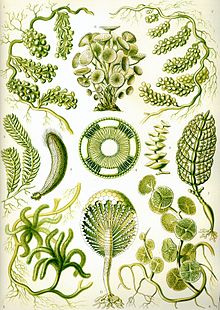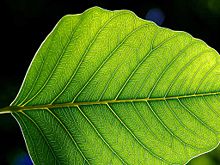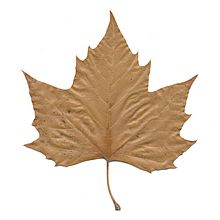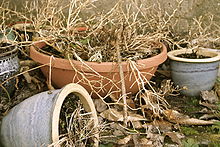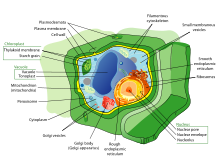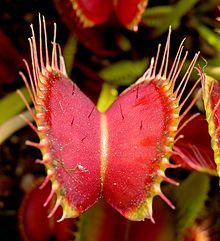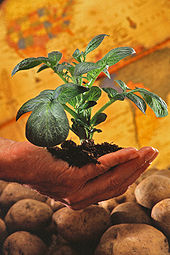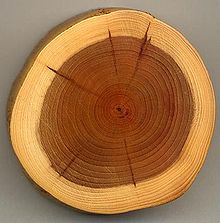- Plant
-
For other uses, see Plant (disambiguation).
Plants
Temporal range:
Early Cambrian to recent, but see text, 520–0 Ma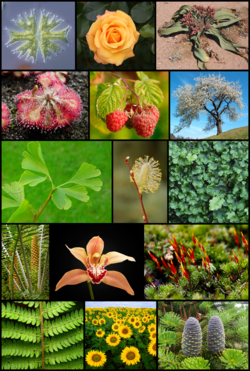
Scientific classification Domain: Eukaryota (unranked): Archaeplastida Kingdom: Plantae
Haeckel, 1866[1]Divisions Land plants (embryophytes)
- Non-vascular land plants (bryophytes)
- Marchantiophyta—liverworts
- Anthocerotophyta—hornworts
- Bryophyta—mosses
- †Horneophytopsida
- Vascular plants (tracheophytes)
- †Rhyniophyta—rhyniophytes
- †Zosterophyllophyta—zosterophylls
- Lycopodiophyta—clubmosses
- †Trimerophytophyta—trimerophytes
- Pteridophyta—ferns and horsetails
- †Progymnospermophyta
- Seed plants (spermatophytes)
- †Pteridospermatophyta—seed ferns
- Pinophyta—conifers
- Cycadophyta—cycads
- Ginkgophyta—ginkgo
- Gnetophyta—gnetae
- Magnoliophyta—flowering plants
†Nematophytes
Plants are living organisms belonging to the kingdom Plantae. Precise definitions of the kingdom vary, but as the term is used here, plants include familiar organisms such as trees, flowers, herbs, bushes, grasses, vines, ferns, mosses, and green algae. The group is also called green plants or Viridiplantae in Latin. They obtain most of their energy from sunlight via photosynthesis using chlorophyll contained in chloroplasts, which gives them their green color. Some plants are parasitic and may not produce normal amounts chlorophyll[citation needed] or photosynthesize.
Precise numbers are difficult to determine, but as of 2010[update], there are thought to be 300–315 thousand species of plants, of which the great majority, some 260–290 thousand, are seed plants (see the table below).[2]
The scientific study of plants is known as botany.
Contents
Definition
Plants are one of the two groups into which all living things are traditionally divided; the other is animals. The division goes back at least as far as Aristotle (384 BC – 322 BC) who distinguished between plants which generally do not move, and animals which often are mobile to catch their food. Much later, when Linnaeus (1707–1778) created the basis of the modern system of scientific classification, these two groups became the kingdoms Vegetabilia (later Metaphyta or Plantae) and Animalia (also called Metazoa). Since then, it has become clear that the plant kingdom as originally defined included several unrelated groups, and the fungi and several groups of algae were removed to new kingdoms. However, these organisms are still often considered plants, particularly in popular contexts.
Outside of formal scientific contexts, the term "plant" implies an association with certain traits, such as being multicellular, possessing cellulose, and having the ability to carry out photosynthesis.[3][4]
Current definitions of Plantae
When the name Plantae or plant is applied to a specific group of organisms or taxon, it usually refers to one of three concepts. From least to most inclusive, these three groupings are:
Name(s) Scope Description Land plants, also known as Embryophyta or Metaphyta. Plantae sensu strictissimo This group includes the liverworts, hornworts, mosses, and vascular plants, as well as fossil plants similar to these surviving groups. Green plants - also known as Viridiplantae, Viridiphyta or Chlorobionta Plantae sensu stricto This group includes the land plants plus various groups of green algae, including stoneworts. The names given to these groups vary considerably as of July 2011[update]. Viridiplantae encompass a group of organisms that possess chlorophyll a and b, have plastids that are bound by only two membranes, are capable of storing starch, and have cellulose in their cell walls. It is this clade which is mainly the subject of this article. Archaeplastida, Plastida or Primoplantae Plantae sensu lato This group comprises the green plants above plus Rhodophyta (red algae) and Glaucophyta (glaucophyte algae). This clade includes the organisms that eons ago acquired their chloroplasts directly by engulfing cyanobacteria. Another way of looking at the relationships between the different groups which have been called "plants" is through a cladogram, which shows their evolutionary relationships. The evolutionary history of plants is not yet completely settled, but one accepted relationship between the three groups described above is shown below.[5] Those which have been called "plants" are in bold.
Archaeplastida Glaucophyta (glaucophyte algae)
Rhodophyta (red algae)
Viridiplantae Chlorophyta (part of green algae)
Streptophyta streptophyte algae (part of green algae)
Charales (stoneworts, often included
in green algae)land plants or embryophytes
groups traditionally called "algae"As is discussed further below, the way in which the groups of green algae are combined and named varies considerably between authors. See also the section Evolution.
Many of the classification controversies involve organisms that are rarely encountered and are of minimal apparent economic significance, but are crucial in developing an understanding of the evolution of modern flora.[citation needed]
Algae
Main article: AlgaeAlgae comprise several different groups of organisms which produce energy through photosynthesis and for that reason have been included in the plant kingdom in the past. Most conspicuous among the algae are the seaweeds, multicellular algae that may roughly resemble land plants, but are classified among the brown, red and green algae. Each of these algal groups also includes various microscopic and single-celled organisms. There is good evidence that some of these algal groups arose independently from separate non-photosynthetic ancestors, with the result that many groups of algae are no longer classified within the plant kingdom as it is defined here.[6][7]
The Viridiplantae, the green plants – green algae and land plants – form a clade, a group consisting of all the descendants of a common ancestor. With a few exceptions among the green algae, all green plants have many features in common, including cell walls containing cellulose, chloroplasts containing chlorophylls a and b, and food stores in the form of starch. They undergo closed mitosis without centrioles, and typically have mitochondria with flat cristae. The chloroplasts of green plants are surrounded by two membranes, suggesting they originated directly from endosymbiotic cyanobacteria.
Two additional groups, the Rhodophyta (red algae) and Glaucophyta (glaucophyte algae), also have chloroplasts which appear to be derived directly from endosymbiotic cyanobacteria, although they differ in the pigments which are used in photosynthesis and so are different in colour. All three groups together are generally believed to have a single common origin, and so are classified together in the taxon Archaeplastida, whose name implies that the chloroplasts or plastids of all the members of the taxon were derived from a single ancient endosymbiotic event. This is the broadest modern definition of the plants.
In contrast, most other algae (e.g. heterokonts, haptophytes, dinoflagellates, and euglenids) not only have different pigments but also have chloroplasts with three or four surrounding membranes. They are not close relatives of the Archaeplastida, presumably having acquired chloroplasts separately from ingested or symbiotic green and red algae. They are thus not included in even the broadest modern definition of the plant kingdom, although they were in the past.
The green plants or Viridiplantae were traditionally divided into the green algae (including the stoneworts) and the land plants. However, it is now known that the land plants evolved from within a group of green algae, so that the green algae by themselves are a paraphyletic group, i.e. a group which excludes some of the descendants of a common ancestor. Paraphyletic groups are generally avoided in modern classifications, so that in recent treatments the Viridiplantae have been divided into two clades, the Chlorophyta and the Streptophyta (or Charophyta).[8][9]
The Chlorophyta (a name that has also been used for all green algae) are the sister group to the group from which the land plants evolved. There are about 4,300 species[10] of mainly marine organisms, both unicellular and multicellular. The latter include the sea lettuce, Ulva.
The other group within the Viridiplantae are the mainly freshwater or terrestrial Streptophyta (or Charophyta), which consist of several groups of green algae plus the stoneworts and land plants. (The names have been used differently, e.g. Streptophyta to mean the group which excludes the land plants and Charophyta for the stoneworts alone or the stoneworts plus the land plants.) Streptophyte algae are either unicellular or form multicellular filaments, branched or unbranched.[9] The genus Spirogyra is a filamentous streptophyte alga familiar to many, as it is often used in teaching and is one of the organisms responsible for the algal "scum" which pond-owners so dislike. The freshwater stoneworts strongly resemble land plants and are believed to be their closest relatives. Growing underwater, they consist of a central stalk with whorls of branchlets, giving them a superficial resemblance to horsetails, species of the genus Equisetum, which are true land plants.
Fungi
Main article: FungiThe classification of fungi has been controversial until quite recently in the history of biology. Linnaeus' original classification placed the fungi within the Plantae, since they were unquestionably not animals or minerals and these were the only other alternatives. With later developments in microbiology, in the 19th century Ernst Haeckel felt that another kingdom was required to classify newly discovered micro-organisms. The introduction of the new kingdom Protista in addition to Plantae and Animalia, led to uncertainty as to whether fungi truly were best placed in the Plantae or whether they ought to be reclassified as protists. Haeckel himself found it difficult to decide and it was not until 1969 that a solution was found whereby Robert Whittaker proposed the creation of the kingdom Fungi. Molecular evidence has since shown that the last common ancestor (concestor) of the Fungi was probably more similar to that of the Animalia than of any other kingdom, including the Plantae.
Whittaker's original reclassification was based on the fundamental difference in nutrition between the Fungi and the Plantae. Unlike plants, which generally gain carbon through photosynthesis, and so are called autotrophic phototrophs, fungi generally obtain carbon by breaking down and absorbing surrounding materials, and so are called heterotrophic saprotrophs. In addition, the substructure of multicellular fungi is different from that of plants, taking the form of many chitinous microscopic strands called hyphae, which may be further subdivided into cells or may form a syncytium containing many eukaryotic nuclei. Fruiting bodies, of which mushrooms are most familiar example, are the reproductive structures of fungi, and are unlike any structures produced by plants.
Diversity
The table below shows some estimates for the numbers of species of different groups of green plants; note as these are from different sources and are of different dates, they are not necessarily comparable, and like all species counts, are subject to a degree of uncertainty in some cases. The table suggests that there are at least 300,000 species of green plants, of which 85-90% are flowering plants. The next largest group are the "bryophytes", liverworts, mosses and hornworts, with 18,000–20,000 species.
Diversity of living plant divisions Informal group Division name Common name No. of living species Green algae Chlorophyta green algae (chlorophytes) 3,800 [11] – 4,300 [12] Charophyta green algae (e.g. desmids & stoneworts) 2,800;[13] 4,000-6,000 [14] Bryophytes Marchantiophyta liverworts 6,000-8,000 [15] Anthocerotophyta hornworts 100-200 [16] Bryophyta mosses 12,000 [17] Pteridophytes Lycopodiophyta club mosses 1,200 [7] Pteridophyta ferns, whisk ferns & horsetails 11,000 [7] Seed plants Cycadophyta cycads 160 [18] Ginkgophyta ginkgo 1 [19] Pinophyta conifers 630 [7] Gnetophyta gnetophytes 70 [7] Magnoliophyta flowering plants 258,650 [20]
The naming of plants is governed by the International Code of Botanical Nomenclature and International Code of Nomenclature for Cultivated Plants (see cultivated plant taxonomy).Evolution
Further information: Evolutionary history of plantsThe evolution of plants has resulted in increasing levels of complexity, from the earliest algal mats, through bryophytes, lycopods, ferns to the complex gymnosperms and angiosperms of today. The groups which appeared earlier continue to thrive, especially in the environments in which they evolved.
Evidence suggests that an algal scum formed on the land 1,200 million years ago, but it was not until the Ordovician Period, around 450 million years ago, that land plants appeared.[21] However, new evidence from the study of carbon isotope ratios in Precambrian rocks has suggested that complex photosynthetic plants developed on the earth over 1000 m.y.a.[22] These began to diversify in the late Silurian Period, around 420 million years ago, and the fruits of their diversification are displayed in remarkable detail in an early Devonian fossil assemblage from the Rhynie chert. This chert preserved early plants in cellular detail, petrified in volcanic springs. By the middle of the Devonian Period most of the features recognised in plants today are present, including roots, leaves and secondary wood, and by late Devonian times seeds had evolved.[23] Late Devonian plants had thereby reached a degree of sophistication that allowed them to form forests of tall trees. Evolutionary innovation continued after the Devonian period. Most plant groups were relatively unscathed by the Permo-Triassic extinction event, although the structures of communities changed. This may have set the scene for the evolution of flowering plants in the Triassic (~200 million years ago), which exploded in the Cretaceous and Tertiary. The latest major group of plants to evolve were the grasses, which became important in the mid Tertiary, from around 40 million years ago. The grasses, as well as many other groups, evolved new mechanisms of metabolism to survive the low CO2 and warm, dry conditions of the tropics over the last 10 million years.
A proposed phylogenetic tree of Plantae, after Kenrick and Crane,[24] is as follows, with modification to the Pteridophyta from Smith et al.[25] The Prasinophyceae may be a paraphyletic basal group to all green plants.
Prasinophyceae (micromonads)
Streptobionta Embryophytes Stomatophytes Polysporangiates Tracheophytes Eutracheophytes Euphyllophytina Lignophytia Spermatophytes (seed plants)
Pteridophyta Pteridopsida (true ferns)
Equisetopsida (horsetails)
Psilotopsida (whisk ferns & adders'-tongues)
Lycophytina Zosterophyllophyta †
Bryophyta (mosses)
Anthocerotophyta (hornworts)
Marchantiophyta (liverworts)
Chlorophyta Trebouxiophyceae (Pleurastrophyceae)
Embryophytes
Main article: Embryophyte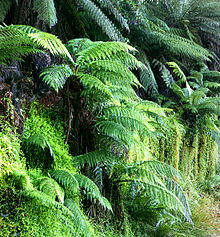 Dicksonia antarctica, a species of tree fern
Dicksonia antarctica, a species of tree fern
The plants that are likely most familiar to us are the multicellular land plants, called embryophytes. They include the vascular plants, plants with full systems of leaves, stems, and roots. They also include a few of their close relatives, often called bryophytes, of which mosses and liverworts are the most common.
All of these plants have eukaryotic cells with cell walls composed of cellulose, and most obtain their energy through photosynthesis, using light and carbon dioxide to synthesize food. About three hundred plant species do not photosynthesize but are parasites on other species of photosynthetic plants. Plants are distinguished from green algae, which represent a mode of photosynthetic life similar to the kind modern plants are believed to have evolved from, by having specialized reproductive organs protected by non-reproductive tissues.
Bryophytes first appeared during the early Paleozoic. They can only survive where moisture is available for significant periods, although some species are desiccation tolerant. Most species of bryophyte remain small throughout their life-cycle. This involves an alternation between two generations: a haploid stage, called the gametophyte, and a diploid stage, called the sporophyte. The sporophyte is short-lived and remains dependent on its parent gametophyte.
Vascular plants first appeared during the Silurian period, and by the Devonian had diversified and spread into many different land environments. They have a number of adaptations that allowed them to overcome the limitations of the bryophytes. These include a cuticle resistant to desiccation, and vascular tissues which transport water throughout the organism. In most the sporophyte acts as a separate individual, while the gametophyte remains small.
The first primitive seed plants, Pteridosperms (seed ferns) and Cordaites, both groups now extinct, appeared in the late Devonian and diversified through the Carboniferous, with further evolution through the Permian and Triassic periods. In these the gametophyte stage is completely reduced, and the sporophyte begins life inside an enclosure called a seed, which develops while on the parent plant, and with fertilisation by means of pollen grains. Whereas other vascular plants, such as ferns, reproduce by means of spores and so need moisture to develop, some seed plants can survive and reproduce in extremely arid conditions.
Early seed plants are referred to as gymnosperms (naked seeds), as the seed embryo is not enclosed in a protective structure at pollination, with the pollen landing directly on the embryo. Four surviving groups remain widespread now, particularly the conifers, which are dominant trees in several biomes. The angiosperms, comprising the flowering plants, were the last major group of plants to appear, emerging from within the gymnosperms during the Jurassic and diversifying rapidly during the Cretaceous. These differ in that the seed embryo (angiosperm) is enclosed, so the pollen has to grow a tube to penetrate the protective seed coat; they are the predominant group of flora in most biomes today.
Fossils
Main articles: Paleobotany and Evolutionary history of plants A petrified log in Petrified Forest National Park.
A petrified log in Petrified Forest National Park.
Plant fossils include roots, wood, leaves, seeds, fruit, pollen, spores, phytoliths, and amber (the fossilized resin produced by some plants). Fossil land plants are recorded in terrestrial, lacustrine, fluvial and nearshore marine sediments. Pollen, spores and algae (dinoflagellates and acritarchs) are used for dating sedimentary rock sequences. The remains of fossil plants are not as common as fossil animals, although plant fossils are locally abundant in many regions worldwide.
The earliest fossils clearly assignable to Kingdom Plantae are fossil green algae from the Cambrian. These fossils resemble calcified multicellular members of the Dasycladales. Earlier Precambrian fossils are known which resemble single-cell green algae, but definitive identity with that group of algae is uncertain.
The oldest known fossils of embryophytes date from the Ordovician, though such fossils are fragmentary. By the Silurian, fossils of whole plants are preserved, including the lycophyte Baragwanathia longifolia. From the Devonian, detailed fossils of rhyniophytes have been found. Early fossils of these ancient plants show the individual cells within the plant tissue. The Devonian period also saw the evolution of what many believe to be the first modern tree, Archaeopteris. This fern-like tree combined a woody trunk with the fronds of a fern, but produced no seeds.
The Coal measures are a major source of Paleozoic plant fossils, with many groups of plants in existence at this time. The spoil heaps of coal mines are the best places to collect; coal itself is the remains of fossilised plants, though structural detail of the plant fossils is rarely visible in coal. In the Fossil Forest at Victoria Park in Glasgow, Scotland, the stumps of Lepidodendron trees are found in their original growth positions.
The fossilized remains of conifer and angiosperm roots, stems and branches may be locally abundant in lake and inshore sedimentary rocks from the Mesozoic and Cenozoic eras. Sequoia and its allies, magnolia, oak, and palms are often found.
Petrified wood is common in some parts of the world, and is most frequently found in arid or desert areas where it is more readily exposed by erosion. Petrified wood is often heavily silicified (the organic material replaced by silicon dioxide), and the impregnated tissue is often preserved in fine detail. Such specimens may be cut and polished using lapidary equipment. Fossil forests of petrified wood have been found in all continents.
Fossils of seed ferns such as Glossopteris are widely distributed throughout several continents of the Southern Hemisphere, a fact that gave support to Alfred Wegener's early ideas regarding Continental drift theory.
Structure, growth, and development
Further information: Plant morphologyMost of the solid material in a plant is taken from the atmosphere. Through a process known as photosynthesis, most plants use the energy in sunlight to convert carbon dioxide from the atmosphere, plus water, into simple sugars. Parasitic plants, on the other hand, use the resources of its host to grow. These sugars are then used as building blocks and form the main structural component of the plant. Chlorophyll, a green-colored, magnesium-containing pigment is essential to this process; it is generally present in plant leaves, and often in other plant parts as well.
Plants usually rely on soil primarily for support and water (in quantitative terms), but also obtain compounds of nitrogen, phosphorus, and other crucial elemental nutrients. Epiphytic and lithophytic plants often depend on rainwater or other sources for nutrients and carnivorous plants supplement their nutrient requirements with insect prey that they capture. For the majority of plants to grow successfully they also require oxygen in the atmosphere and around their roots for respiration. However, some plants grow as submerged aquatics, using oxygen dissolved in the surrounding water, and a few specialized vascular plants, such as mangroves, can grow with their roots in anoxic conditions.
Factors affecting growth
The genotype of a plant affects its growth. For example, selected varieties of wheat grow rapidly, maturing within 110 days, whereas others, in the same environmental conditions, grow more slowly and mature within 155 days.[26]
Growth is also determined by environmental factors, such as temperature, available water, available light, and available nutrients in the soil. Any change in the availability of these external conditions will be reflected in the plants growth.
Biotic factors are also capable of affecting plant growth. Plants compete with other plants for space, water, light and nutrients. Plants can be so crowded that no single individual produces normal growth, causing etiolation and chlorosis. Optimal plant growth can be hampered by grazing animals, suboptimal soil composition, lack of mycorrhizal fungi, and attacks by insects or plant diseases, including those caused by bacteria, fungi, viruses, and nematodes.[26]
Simple plants like algae may have short life spans as individuals, but their populations are commonly seasonal. Other plants may be organized according to their seasonal growth pattern: annual plants live and reproduce within one growing season, biennial plants live for two growing seasons and usually reproduce in second year, and perennial plants live for many growing seasons and continue to reproduce once they are mature. These designations often depend on climate and other environmental factors; plants that are annual in alpine or temperate regions can be biennial or perennial in warmer climates. Among the vascular plants, perennials include both evergreens that keep their leaves the entire year, and deciduous plants which lose their leaves for some part of it. In temperate and boreal climates, they generally lose their leaves during the winter; many tropical plants lose their leaves during the dry season.
The growth rate of plants is extremely variable. Some mosses grow less than 0.001 millimeters per hour (mm/h), while most trees grow 0.025-0.250 mm/h. Some climbing species, such as kudzu, which do not need to produce thick supportive tissue, may grow up to 12.5 mm/h.
Plants protect themselves from frost and dehydration stress with antifreeze proteins, heat-shock proteins and sugars (sucrose is common). LEA (Late Embryogenesis Abundant) protein expression is induced by stresses and protects other proteins from aggregation as a result of desiccation and freezing.[27]
Plant cell
Main article: Plant cellPlant cells are typically distinguished by their large water-filled central vacuole, chloroplasts, and rigid cell walls that are made up of cellulose, hemicellulose, and pectin. Cell division is also characterized by the development of a phragmoplast for the construction of a cell plate in the late stages of cytokinesis. Just as in animals, plant cells differentiate and develop into multiple cell types. Totipotent meristematic cells can differentiate into vascular, storage, protective (e.g. epidermal layer), or reproductive tissues, with more primitive plants lacking some tissue types.[28]
Physiology
Main article: Plant physiologyPhotosynthesis
Main articles: Photosynthesis and Biological pigmentPlants are photosynthetic, which means that they manufacture their own food molecules using energy obtained from light. The primary mechanism plants have for capturing light energy is the pigment chlorophyll. All green plants contain two forms of chlorophyll, chlorophyll a and chlorophyll b. The latter of these pigments is not found in red or brown algae.
Immune system
By means of cells that behave like nerves, plants receive and distribute within their systems information about incident light intensity and quality. Incident light which stimulates a chemical reaction in one leaf, will cause a chain reaction of signals to the entire plant via a type of cell termed a "bundle sheath cell". Researchers from the Warsaw University of Life Sciences in Poland, found that plants have a specific memory for varying light conditions which prepares their immune systems against seasonal pathogens.[29]
Internal distribution
Main article: Vascular tissueVascular plants differ from other plants in that they transport nutrients between different parts through specialized structures, called xylem and phloem. They also have roots for taking up water and minerals. The xylem moves water and minerals from the root to the rest of the plant, and the phloem provides the roots with sugars and other nutrient produced by the leaves.[28]
Ecology
Main article: Plant ecologyThe photosynthesis conducted by land plants and algae is the ultimate source of energy and organic material in nearly all ecosystems. Photosynthesis radically changed the composition of the early Earth's atmosphere, which as a result is now 21% oxygen. Animals and most other organisms are aerobic, relying on oxygen; those that do not are confined to relatively rare anaerobic environments. Plants are the primary producers in most terrestrial ecosystems and form the basis of the food web in those ecosystems. Many animals rely on plants for shelter as well as oxygen and food.
Land plants are key components of the water cycle and several other biogeochemical cycles. Some plants have coevolved with nitrogen fixing bacteria, making plants an important part of the nitrogen cycle. Plant roots play an essential role in soil development and prevention of soil erosion.
Distribution
Plants are distributed worldwide in varying numbers. While they inhabit a multitude of biomes and ecoregions, few can be found beyond the tundras at the northernmost regions of continental shelves. At the southern extremes, plants have adapted tenaciously to the prevailing conditions. (See Antarctic flora.)
Plants are often the dominant physical and structural component of habitats where they occur. Many of the Earth's biomes are named for the type of vegetation because plants are the dominant organisms in those biomes, such as grasslands and forests.
Ecological relationships
Numerous animals have coevolved with plants. Many animals pollinate flowers in exchange for food in the form of pollen or nectar. Many animals disperse seeds, often by eating fruit and passing the seeds in their feces. Myrmecophytes are plants that have coevolved with ants. The plant provides a home, and sometimes food, for the ants. In exchange, the ants defend the plant from herbivores and sometimes competing plants. Ant wastes provide organic fertilizer.
The majority of plant species have various kinds of fungi associated with their root systems in a kind of mutualistic symbiosis known as mycorrhiza. The fungi help the plants gain water and mineral nutrients from the soil, while the plant gives the fungi carbohydrates manufactured in photosynthesis. Some plants serve as homes for endophytic fungi that protect the plant from herbivores by producing toxins. The fungal endophyte, Neotyphodium coenophialum, in tall fescue (Festuca arundinacea) does tremendous economic damage to the cattle industry in the U.S.
Various forms of parasitism are also fairly common among plants, from the semi-parasitic mistletoe that merely takes some nutrients from its host, but still has photosynthetic leaves, to the fully parasitic broomrape and toothwort that acquire all their nutrients through connections to the roots of other plants, and so have no chlorophyll. Some plants, known as myco-heterotrophs, parasitize mycorrhizal fungi, and hence act as epiparasites on other plants.
Many plants are epiphytes, meaning they grow on other plants, usually trees, without parasitizing them. Epiphytes may indirectly harm their host plant by intercepting mineral nutrients and light that the host would otherwise receive. The weight of large numbers of epiphytes may break tree limbs. Hemiepiphytes like the strangler fig begin as epiphytes but eventually set their own roots and overpower and kill their host. Many orchids, bromeliads, ferns and mosses often grow as epiphytes. Bromeliad epiphytes accumulate water in leaf axils to form phytotelmata, complex aquatic food webs.[30]
Approximately 630 plants are carnivorous, such as the Venus Flytrap (Dionaea muscipula) and sundew (Drosera species). They trap small animals and digest them to obtain mineral nutrients, especially nitrogen and phosphorus.[31]
Importance
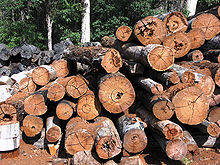 Timber in storage for later processing at a sawmill.
Timber in storage for later processing at a sawmill.
The study of plant uses by people is termed economic botany or ethnobotany; some consider economic botany to focus on modern cultivated plants, while ethnobotany focuses on indigenous plants cultivated and used by native peoples. Human cultivation of plants is part of agriculture, which is the basis of human civilization. Plant agriculture is subdivided into agronomy, horticulture and forestry.
Food
Much of human nutrition depends on land plants, either directly or indirectly.
Human nutrition depends to a large extent on cereals, especially maize (or corn), wheat and rice. Other staple crops include potato, cassava, and legumes. Human food also includes vegetables, spices, and certain fruits, nuts, herbs, and edible flowers.
Beverages produced from plants include coffee, tea, wine, beer and alcohol.
Sugar is obtained mainly from sugar cane and sugar beet.
Cooking oils and margarine come from maize, soybean, rapeseed, safflower, sunflower, olive and others.
Food additives include gum arabic, guar gum, locust bean gum, starch and pectin.
Livestock animals including cows, pigs, sheep, and goats are all herbivores; and feed primarily or entirely on cereal plants, particularly grasses.Nonfood products
Wood is used for buildings, furniture, paper, cardboard, musical instruments and sports equipment. Cloth is often made from cotton, flax or synthetic fibers derived from cellulose, such as rayon and acetate. Renewable fuels from plants include firewood, peat and many other biofuels. Coal and petroleum are fossil fuels derived from plants. Medicines derived from plants include aspirin, taxol, morphine, quinine, reserpine, colchicine, digitalis and vincristine. There are hundreds of herbal supplements such as ginkgo, Echinacea, feverfew, and Saint John's wort. Pesticides derived from plants include nicotine, rotenone, strychnine and pyrethrins. Drugs obtained from plants include opium, cocaine and marijuana. Poisons from plants include ricin, hemlock and curare. Plants are the source of many natural products such as fibers, essential oils, natural dyes, pigments, waxes, tannins, latex, gums, resins, alkaloids, amber and cork. Products derived from plants include soaps, paints, shampoos, perfumes, cosmetics, turpentine, rubber, varnish, lubricants, linoleum, plastics, inks, chewing gum and hemp rope. Plants are also a primary source of basic chemicals for the industrial synthesis of a vast array of organic chemicals. These chemicals are used in a vast variety of studies and experiments.
Aesthetic uses
Thousands of plant species are cultivated for aesthetic purposes as well as to provide shade, modify temperatures, reduce wind, abate noise, provide privacy, and prevent soil erosion. People use cut flowers, dried flowers and houseplants indoors or in greenhouses. In outdoor gardens, lawn grasses, shade trees, ornamental trees, shrubs, vines, herbaceous perennials and bedding plants are used. Images of plants are often used in art, architecture, humor, language, and photography and on textiles, money, stamps, flags and coats of arms. Living plant art forms include topiary, bonsai, ikebana and espalier. Ornamental plants have sometimes changed the course of history, as in tulipomania. Plants are the basis of a multi-billion dollar per year tourism industry which includes travel to arboretums, botanical gardens, historic gardens, national parks, tulip festivals, rainforests, forests with colorful autumn leaves and the National Cherry Blossom Festival. Venus Flytrap, sensitive plant and resurrection plant are examples of plants sold as novelties.
Scientific and cultural uses
Tree rings are an important method of dating in archeology and serve as a record of past climates. Basic biological research has often been done with plants, such as the pea plants used to derive Gregor Mendel's laws of genetics. Space stations or space colonies may one day rely on plants for life support. Plants are used as national and state emblems, including state trees and state flowers. Ancient trees are revered and many are famous. Numerous world records are held by plants. Plants are often used as memorials, gifts and to mark special occasions such as births, deaths, weddings and holidays. Plants figure prominently in mythology, religion and literature. The field of ethnobotany studies plant use by indigenous cultures which helps to conserve endangered species as well as discover new medicinal plants. Gardening is the most popular leisure activity in the U.S. Working with plants or horticulture therapy is beneficial for rehabilitating people with disabilities. Certain plants contain psychotropic chemicals which are extracted and ingested, including tobacco, cannabis (marijuana), and opium.
Negative effects
Weeds are plants that grow where people do not want them. People have spread plants beyond their native ranges and some of these introduced plants become invasive, damaging existing ecosystems by displacing native species. Invasive plants cause billions of dollars in crop losses annually by displacing crop plants, they increase the cost of production and the use of chemical means to control them affects the environment.
Plants may cause harm to animals, including people. Plants that produce windblown pollen invoke allergic reactions in people who suffer from hay fever. A wide variety of plants are poisonous. Toxalbumins are plant poisons fatal to most mammals and act as a serious deterrent to consumption. Several plants cause skin irritations when touched, such as poison ivy. Certain plants contain psychotropic chemicals, which are extracted and ingested or smoked, including tobacco, cannabis (marijuana), cocaine and opium. Smoking causes damage to health or even death, while some drugs may also be harmful or fatal to people.[32][33] Both illegal and legal drugs derived from plants may have negative effects on the economy, affecting worker productivity and law enforcement costs.[34][35] Some plants cause allergic reactions when ingested, while other plants cause food intolerances that negatively affect health.
See also
- The Plant List
- Biosphere
- Leaf sensor
- Plant defense against herbivory
- Plant perception (paranormal)
- Plant perception (physiology)
- Plant identification
- Rapid plant movement
- Biological exponential growth
- Germination
References
- ^ Haeckel G (1866). Generale Morphologie der Organismen. Berlin: Verlag von Georg Reimer. pp. vol.1: i–xxxii, 1–574, pls I–II; vol. 2: i–clx, 1–462, pls I–VIII.
- ^ http://www.iucnredlist.org/documents/summarystatistics/2010_1RL_Stats_Table_1.pdf
- ^ "plant[2 - Definition from the Merriam-Webster Online Dictionary"]. http://www.merriam-webster.com/dictionary/plant%5B2%5D. Retrieved 2009-03-25.
- ^ "plant (life form) -- Britannica Online Encyclopedia". http://www.britannica.com/EBchecked/topic/463192/plant. Retrieved 2009-03-25.
- ^ Based on Rogozin, I.B.; Basu, M.K.; Csürös, M. & Koonin, E.V. (2009), "Analysis of Rare Genomic Changes Does Not Support the Unikont–Bikont Phylogeny and Suggests Cyanobacterial Symbiosis as the Point of Primary Radiation of Eukaryotes", Genome Biology and Evolution 1: 99–113, doi:10.1093/gbe/evp011, PMC 2817406, PMID 20333181, http://www.pubmedcentral.nih.gov/articlerender.fcgi?tool=pmcentrez&artid=2817406 and Becker, B. & Marin, B. (2009), "Streptophyte algae and the origin of embryophytes", Annals of Botany 103 (7): 999–1004, doi:10.1093/aob/mcp044, PMC 2707909, PMID 19273476, http://www.pubmedcentral.nih.gov/articlerender.fcgi?tool=pmcentrez&artid=2707909; see also the slightly different cladogram in Lewis, Louise A. & McCourt, R.M. (2004), "Green algae and the origin of land plants", Am. J. Bot. 91 (10): 1535–1556, doi:10.3732/ajb.91.10.1535, PMID 21652308.
- ^ Margulis, L. (1974). "Five-kingdom classification and the origin and evolution of cells". Evolutionary Biology 7: 45–78.
- ^ a b c d e Raven, Peter H., Ray F. Evert, & Susan E. Eichhorn, 2005. Biology of Plants, 7th edition. (New York: W. H. Freeman and Company). ISBN 0-7167-1007-2.
- ^ Lewis, Louise A. & McCourt, R.M. (2004), "Green algae and the origin of land plants", Am. J. Bot. 91 (10): 1535–1556, doi:10.3732/ajb.91.10.1535
- ^ a b Becker, B. & Marin, B. (2009), "Streptophyte algae and the origin of embryophytes", Annals of Botany 103 (7): 999–1004, doi:10.1093/aob/mcp044, PMC 2707909, PMID 19273476, http://www.pubmedcentral.nih.gov/articlerender.fcgi?tool=pmcentrez&artid=2707909
- ^ Guiry, M.D. & Guiry, G.M. (2007). "Phylum: Chlorophyta taxonomy browser". AlgaeBase version 4.2 World-wide electronic publication, National University of Ireland, Galway. http://www.algaebase.org/browse/taxonomy/?id=4307. Retrieved 2007-09-23.
- ^ Van den Hoek, C., D. G. Mann, & H. M. Jahns, 1995. Algae: An Introduction to Phycology. pages 343, 350, 392, 413, 425, 439, & 448 (Cambridge: Cambridge University Press). ISBN 0-521-30419-9
- ^ Guiry, M.D. & Guiry, G.M. (2011), AlgaeBase : Chlorophyta, World-wide electronic publication, National University of Ireland, Galway, http://www.algaebase.org/browse/taxonomy/?searching=true&gettaxon=Chlorophyta, retrieved 2011-07-26
- ^ Guiry, M.D. & Guiry, G.M. (2011), AlgaeBase : Charophyta, World-wide electronic publication, National University of Ireland, Galway, http://www.algaebase.org/browse/taxonomy/?searching=true&gettaxon=Charophyta, retrieved 2011-07-26
- ^ Van den Hoek, C., D. G. Mann, & H. M. Jahns, 1995. Algae: An Introduction to Phycology. pages 457, 463, & 476. (Cambridge: Cambridge University Press). ISBN 0-521-30419-9
- ^ Crandall-Stotler, Barbara. & Stotler, Raymond E., 2000. "Morphology and classification of the Marchantiophyta". page 21 in A. Jonathan Shaw & Bernard Goffinet (Eds.), Bryophyte Biology. (Cambridge: Cambridge University Press). ISBN 0-521-66097-1
- ^ Schuster, Rudolf M., The Hepaticae and Anthocerotae of North America, volume VI, pages 712-713. (Chicago: Field Museum of Natural History, 1992). ISBN 0-914-86821-7.
- ^ Goffinet, Bernard; William R. Buck (2004). "Systematics of the Bryophyta (Mosses): From molecules to a revised classification". Monographs in Systematic Botany (Missouri Botanical Garden Press) 98: 205–239.
- ^ Gifford, Ernest M. & Adriance S. Foster, 1988. Morphology and Evolution of Vascular Plants, 3rd edition, page 358. (New York: W. H. Freeman and Company). ISBN 0-7167-1946-0.
- ^ Taylor, Thomas N. & Edith L. Taylor, 1993. The Biology and Evolution of Fossil Plants, page 636. (New Jersey: Prentice-Hall). ISBN 0-13-651589-4.
- ^ International Union for Conservation of Nature and Natural Resources, 2006. IUCN Red List of Threatened Species:Summary Statistics
- ^ "The oldest fossils reveal evolution of non-vascular plants by the middle to late Ordovician Period (~450-440 m.y.a.) on the basis of fossil spores" Transition of plants to land
- ^ "The apparent dominance of eukaryotes in non-marine settings by 1 Gyr ago indicates that eukaryotic evolution on land may have commenced far earlier than previously thought." Earth’s earliest non-marine eukaryotes
- ^ Rothwell, G. W.; Scheckler, S. E.; Gillespie, W. H. (1989). "Elkinsia gen. nov., a Late Devonian gymnosperm with cupulate ovules". Botanical Gazette 150 (2): 170–189. doi:10.1086/337763.
- ^ Kenrick, Paul & Peter R. Crane. 1997. The Origin and Early Diversification of Land Plants: A Cladistic Study. (Washington, D.C.: Smithsonian Institution Press). ISBN 1-56098-730-8.
- ^ Smith, Alan R., Kathleen M. Pryer, E. Schuettpelz, P. Korall, H. Schneider, & Paul G. Wolf. (2006). "A classification for extant ferns". Taxon 55(3): 705-731.
- ^ a b Robbins, W.W., Weier, T.E., et al., Botany:Plant Science, 3rd edition , Wiley International, New York, 1965.
- ^ Goyal, K., Walton, L. J., & Tunnacliffe, A. (2005). "LEA proteins prevent protein aggregation due to water stress". Biochemical Journal 388 (Part 1): 151–157. doi:10.1042/BJ20041931. PMC 1186703. PMID 15631617. Archived from the original on 2009-08-03. http://www.webcitation.org/5il9QhYT0.
- ^ a b Campbell, Reece, Biology, 7th edition, Pearson/Benjamin Cummings, 2005.
- ^ BBC Report
- ^ Howard Frank, Bromeliad Phytotelmata, October 2000
- ^ Barthlott, W., S. Porembski, R. Seine, and I. Theisen. 2007. The Curious World of Carnivorous Plants: A Comprehensive Guide to Their Biology and Cultivation. Timber Press: Portland, Oregon.
- ^ "cocaine/crack". http://www.urban75.com/Drugs/drugcoke.html.
- ^ "Deaths related to cocaine". http://ar2005.emcdda.europa.eu/en/page050-en.html.
- ^ "Illegal drugs drain $160 billion a year from American economy". Archived from the original on 2008-02-15. http://web.archive.org/web/20080215071055/http://www.whitehousedrugpolicy.gov/NEWS/press02/012302.html.
- ^ "The social cost of illegal drug consumption in Spain". http://www.ingentaconnect.com/content/bsc/add/2002/00000097/00000009/art00012.
Further reading
- General
- Evans, L. T. (1998). Feeding the Ten Billion - Plants and Population Growth. Cambridge University Press. Paperback, 247 pages. ISBN 0-521-64685-5.
- Kenrick, Paul & Crane, Peter R. (1997). The Origin and Early Diversification of Land Plants: A Cladistic Study. Washington, D. C.: Smithsonian Institution Press. ISBN 1-56098-730-8.
- Raven, Peter H., Evert, Ray F., & Eichhorn, Susan E. (2005). Biology of Plants (7th ed.). New York: W. H. Freeman and Company. ISBN 0-7167-1007-2.
- Taylor, Thomas N. & Taylor, Edith L. (1993). The Biology and Evolution of Fossil Plants. Englewood Cliffs, NJ: Prentice Hall. ISBN 0-13-651589-4.
- Trewavas, A. (2003). Aspects of Plant Intelligence, Annals of Botany 92: 1-20.
- Species estimates and counts
- International Union for Conservation of Nature and Natural Resources (IUCN) Species Survival Commission (2004). IUCN Red List [1].
- Prance, G. T. (2001). Discovering the Plant World. Taxon 50: 345-359.
External links
- Chaw, S.-M. et al. (1997). "Molecular Phylogeny of Extant Gymnosperms and Seed Plant Evolution: Analysis of Nuclear 18s rRNA Sequences". Molec. Biol. Evol. 14 (1): 56–68. PMID 9000754. http://mbe.library.arizona.edu/data/1997/1401/7chaw.pdf.
- Index Nominum Algarum
- Interactive Cronquist classification
- Plant Photo Gallery of Japan - Flavon's Wild herb and Alpine plants
- Plant Picture Gallery
- Plant Resources of Tropical Africa
- www.prota.org - PROTA’s mission
- Tree of Life
- Botanical and vegetation databases
- African Plants Initiative database
- Australia
- Chilean plants at Chilebosque
- Dave's garden plenty of information mostly about garden plants
- e-Floras (Flora of China, Flora of North America and others)
- Flora Europaea
- Flora of Central Europe (German)
- Flora of North America
- List of Japanese Wild Plants Online
- Meet the Plants-National Tropical Botanical Garden
- Lady Bird Johnson Wildflower Center - Native Plant Information Network at University of Texas, Austin
- The Plant List
- United States Department of Agriculture not limited to continental US species
Botany Subdisciplines of botany Ethnobotany · Paleobotany · Plant anatomy · Plant ecology · Plant evo-devo · Plant morphology · Plant physiology
Plants Plant parts Plant cells Plant reproduction Plant taxonomy Glossaries Category · Portal Classification of Archaeplastida / Plantae sensu lato Rhodophyta Cyanidiophyceae · Porphyridiophyceae · Compsopogonophyceae · Stylonematophyceae · Rhodellophyceae · Bangiophyceae · Florideophyceae (Hildenbrandiales, Acrochaetiales, Nemaliales, Batrachospermales, Corallinales, Gelidiales, Gracilariales, Ceramiales)Glaucocystophyceae Glaucocystis · Cyanophora · GloeochaeteViridiplantae/
Plantae
sensu strictoEuphyllophytaMoniliformopses (Equisetopsida, Filicopsida, Psilotopsida)
Spermatophyta: Gymnosperm (Pinophyta, Cycadophyta, Ginkgophyta, Gnetophyta) · MagnoliophytaSee also: list of plant ordersEukaryota Bikonta AH/SARAHSARHalvariaHeterokont ("S")Unikonta Apusomonadida (Apusomonas, Amastigomonas) · Ancyromonadida (Ancyromonas) · Hemimastigida (Hemimastix, Spironema, Stereonema)HolozoaDermocystida · IchthyophonidaFilozoaFilastereaCapsaspora · MinisteriaChoanoflagellateaElements of nature Universe Earth Earth science · Future of the Earth · Geological history of Earth · Geology · History of the Earth · Plate tectonics · Structure of the EarthWeather Environment Life Biology · Eukaryota (Plants/Flora, Animals/Fauna, Fungi, Protista) · Evolutionary history of life · Hierarchy of life · Life on Earth · Origin of life · Prokaryotes (Archaea, Bacteria) · VirusesCategory · Portal Categories:- Plants
- Plant taxonomy
- Non-vascular land plants (bryophytes)
Wikimedia Foundation. 2010.

